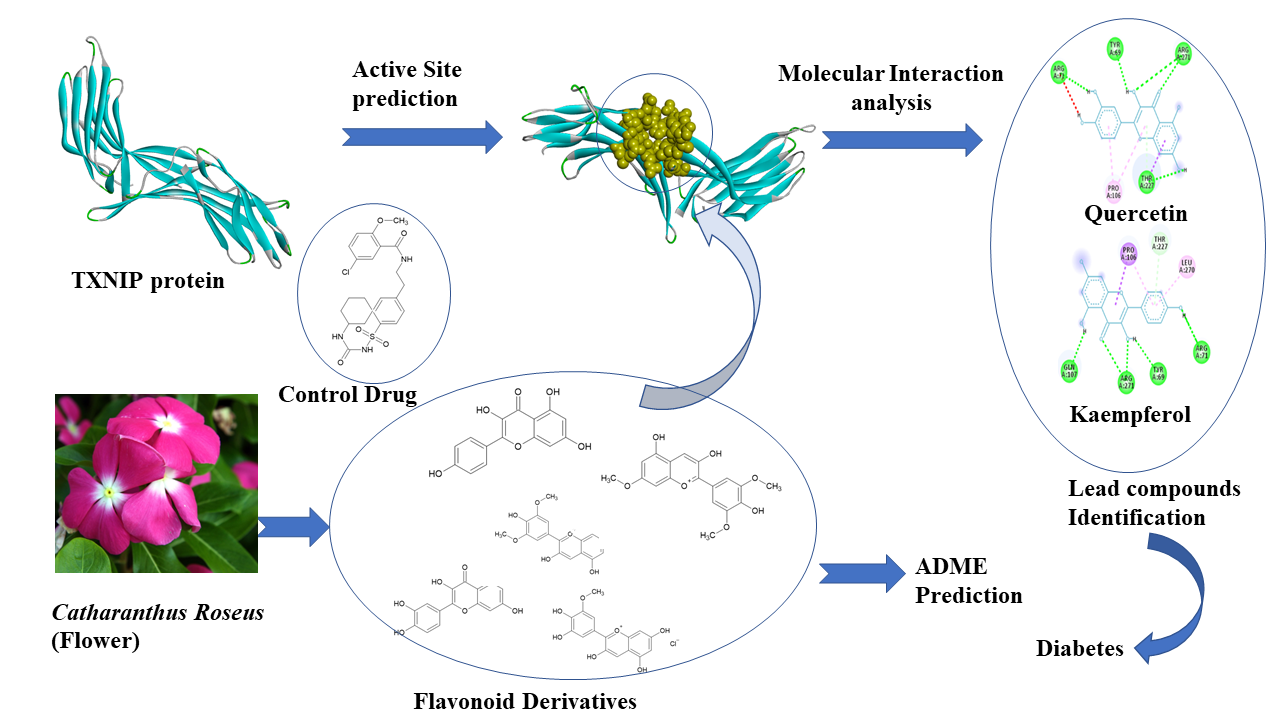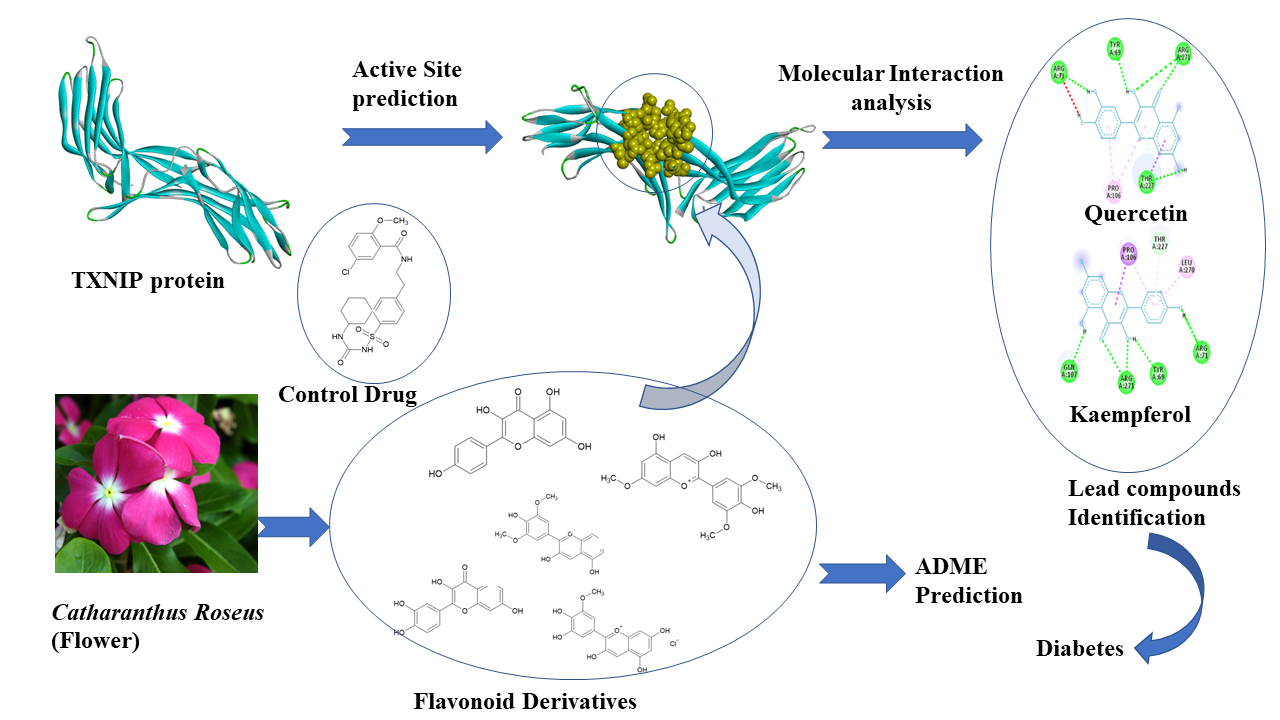In Silico Molecular Interaction Analysis and Pharmacokinetic Profiling of Flavonoids from Catharanthus roseus (Flower) Against TXNIP Protein
DOI:
https://doi.org/10.48048/tis.2023.6394Keywords:
Diabetes mellitus, TXNIP, Catharanthus roseus, Flavonoids, Molecular dockingAbstract
Catharanthus roseus is a flowering plant whose flowers have been used in traditional medicine to treat diabetes mellitus. Some of the flavonoids present in these flowers, namely, quercetin, petunidin, malvidin, kaempferol, and hirsutidin were utilized for studying molecular interaction analysis. Diabetes mellitus which is a metabolic disorder caused by the depletion in the secretion of insulin, which regulates the blood glucose levels by facilitating the metabolism of glucose. Reduction in insulin secretion is often caused by the loss of beta cells of the pancreas. Thioredoxin-interacting protein (TXNIP) is an alpha arrestin which inhibits the production of thioredoxin. It can regulate the beta cells and its inhibition can be advantageous. Reduction in insulin secretion is often caused by the loss of beta cells of the pancreas. Studies have shown that elevated levels of TXNIP can induce apoptosis in beta cells while deficiency of TXNIP leads to protection against Type I & II diabetes due to beta cell survival. To study molecular interactions, flavonoids from the flower of C. roseus and control drug glibenclamide were subjected to docking against 3D structure of TXNIP protein using Autodock 4.2 and their molecular interactions were visualized using a Biovia discovery studio visualizer. Docking interactions and ADMET studies of the bioactive compounds signified the application of C. roseus as a natural therapeutic agent to combat diabetes.
HIGHLIGHTS
- Studies have shown elevated levels of TXNIP can induce apoptosis in beta cells while deficiency of TXNIP leads to protection against diabetes type I & II due to beta cell survival
- Molecular interaction analysis of flavonoids namely, quercetin, petunidin, malvidin, kaempferol, and hirsutidin from Catharanthus roseus (Flower) against TXNIP Protein were utilized for studying using Autodock 4.2 software
- ADMET study of the selected bioactive compounds were carried out
- Docking interactions and ADMET studies of the bioactive compounds signified the application of roseus as a natural therapeutic agent to combat diabetes
GRAPHICAL ABSTRACT 
Downloads
Metrics
References
MA Ganie and S Kotwal. Recent advances in management of diabetes mellitus. J. Int. Med. Sci. Acad. 2012; 25, 171-5.
International Diabetes Federation. Diabetes atlas. International Diabetes Federation. Brussels, Belgium, 2013.
CY Liu, YN Hao, F Yin, YL Zhang and J Liu. Geniposide accelerates proteasome degradation of Txnip to inhibit insulin secretion in pancreatic β-cells. J. Endocrinol. Investig. 2017; 40, 505-12.
E Yoshihara, S Masaki, Y Matsuo, Z Chen, H Tian and J. Yodoi. Thioredoxin/TXNIP: Redoxisome, as a redox switch for the pathogenesis of diseases. Front. Immunol. 2014; 4, 514.
NM Alhawiti, S Al-Mahri, MA Aziz, SS Malik and S. Mohammad. TXNIP in metabolic regulation: Physiological role and therapeutic outlook. Curr. Drug Targets 2017; 18, 1095-103.
DZ Wondafrash, AT Nire’a, GG Tafere, DM Desta, DA Berhe and KA Zewdie. Thioredoxin-interacting protein as a novel potential therapeutic target in diabetes mellitus and its underlying complications. Diabetes Metab. Syndrome Obes. 2020; 13, 43-51.
M Jayanthi, N Sowbala, G Rajalakshmi, U Kanagavalli and V Sivakumar. Study of anti hyperglycemic effect of Catharanthus roseus in alloxan induced diabetic rats. Int. J. Pharm. Pharmaceut. Sci. 2010; 2, 114-6.
E Vega-Ávila, JL Cano-Velasco, FJ Alarcón-Aguilar, C Fajardo OrtízMdel, JC Almanza-Pérez and R Román-Ramos. Hypoglycemic activity of aqueous extracts from Catharanthus roseus. Evid. Base. Compl. Alternative Med. 2012; 2012, 934258.
N Saul, K Pietsch, R Menzel, SR Stürzenbaum and CE Steinberg. Catechin induced longevity in C. elegans: From key regulator genes to disposable soma. Mech. Ageing Dev. 2009; 130, 477-86.
HM Eid and PS Haddad. The antidiabetic potential of quercetin: Underlying mechanisms. Curr. Med. Chem. 2017; 24, 355-64.
C Sun, C Zhao, E Capanoglu, P Paoli, J Simal-Gandara, K Ramkumar, W Shengpeng, B Florina, P Ana, T Vladiana, D Georgiana, D Simona, T Merve, K Washim, W Mingfu, D Dominique, PP Maria, D Parsa, C Lei and J Xiao. Dietary polyphenols as antidiabetic agents: Advances and opportunities. Food Front. 2020; 1, 18-44.
Y Zang, H Sato, and K Igarashi. Anti-diabetic effects of a kaempferol glycoside-rich fraction from unripe soybean (Edamame, Glycine max L. Merrill. ‘Jindai’) Leaves on KK-Ay Mice. Biosci. Biotechnol. Biochem. 2011; 75, 1677-84.
JS Park, HS Rho, DH Kim and IS Chang. Enzymatic preparation of kaempferol from green tea seed and its antioxidant activity. J. Agr. Food Chem. 2006; 54, 2951-6.
XK Fang, J Gao and DN Zhu. Kaempferol and quercetin isolated from euonymus alatus improve glucose uptake of 3T3-L1 cells without adipogenesis activity. Life Sci. 2008; 82, 615-22.
SJN Tatsimo, JDD Tamokou, L Havyarimana, D Csupor, P Forgo, J Hohmann, JR Kuiate and P Tane. Antimicrobial and antioxidant activity of kaempferol rhamnoside derivatives from Bryophyllumpinnatum. BMC Res. Notes 2012; 5, 158.
M Miyazawa, Y Okuno, S Nakamura and H Kosaka. Antimutagenic activity of flavonoids from Pogostemoncablin. J. Agr. Food Chem. 2000; 48, 642-7.
RJ Williams, PE Spencer and C Rice-Evans. Flavonoids: antioxidants or signalling molecules? Free Radic. Biol. Med. 2004; 36, 838-49.
HK Obied, MS Allen, NR Bedgood, PD Prenzler, K Robards and R Stockman. Bioactivity and analysis of biofenols recovered from olive mill waste. J. Agr. Food Chem. 2005, 53, 823-37.
CA Rice-Evans and NJ Miller. Antioxidant activities of flavonoids as bioactive components of food. Biochem. Soc. Trans. 1996; 24, 790-5.
S Zheng, Z Deng, F Chen, L Zheng, Y Pan, Q Xing, R Tsao and H Li. Synergistic antioxidant effects of petunidin and lycopene in H9c2 cells submitted to hydrogen peroxide: Role of Akt/Nrf2 pathway. J. Food Sci. 2020, 85, 1752-63.
P Tolambiya and S Mathur. A study on potential phytopharmaceuticals assets in catharanthus roseus L.(Alba). Int. J. Life Sci. Biotechnol. Pharma Res. 2016; 5, 1-6.
W Tian, C Chen, X Lei, J Zhao and J Liang. CASTp 3.0: Computed atlas of surface topography of proteins. Nucleic Acids Res. 2018; 46, W363-7.
NMO Boyle, M Banck, CA James, C Morley, T Vandermeersch and GR Hutchison. Open babel: An open chemical toolbox. J. Cheminformatics 2011; 3, 33.
A Jarrahpour, J Fathi, M Mimouni, MH Youssoufi, M Mimouni, ZH Chohan and TB Hadda. Petra, osiris and molinspiration (POM) together as a successful support in drug design: Antibacterial activity and biopharmaceutical characterization of some azo Schiff bases. Med. Chem. Res. 2012; 21, 1984-90.
CA Lipinski, F Lombardo, BW Dominy and PJ Feeney. Experimental and computational approaches to estimate solubility and permeability in drug discovery and development settings. Adv. Drug Deliv. Rev. 2001; 46, 3-26.
DE Pires, TL Blundell and DB Ascher. pkCSM: Predicting small-molecule pharmacokinetic properties using graph-based signatures. J. Med. Chem. 2015; 58, 4066-72.
GM Morris, DS Goodsell, RS Halliday, R Huey, WE Hart, RK Belew and AJ Olson. Automated docking using a Lamarckian genetic algorithm and an empirical binding free energy function. J. Comput. Chem. 1998; 19, 1639-62.
L Design. Pharmacophore and ligand-based design with Biovia Discovery Studio®. BIOVIA. California, 2014.
KC Cheng, WA Korfmacher, RE White and FG Njoroge. Lead optimization in discovery drug metabolism and pharmacokinetics/case study: The hepatitis C virus (HCV) protease inhibitor SCH 503034. Perspect. Med. Chem. 2007; 1, 1-9.
MP Gleeson. Generation of a set of simple, interpretable ADMET rules of thumb. J. Med. Chem. 2008; 51, 817-34.
AN Nordqvist, T Tuulikki Lindmark, A Eriksson, P Garberg and K Mats. A general model for prediction of Caco-2 cell permeability. QSAR Combin. Sci. 2004; 23, 303-10.
DEV Pires, LM Kaminskas and DB Ascher. Prediction and optimization of pharmacokinetic and toxicity properties of the ligand. Meth. Mol. Biol. 2018; 1762, 271-84.
D Lagorce, D Douguet, MA Miteva and BO Villoutreix. In ADMET for medicinal chemists: A Practical guide (eds K. Tsaioun & S. A. Kates). John Wiley & Sons, Inc. New Jersey, 2010.
D Lagorce, D Douguet, MA Miteva and BO Villoutreix. Computational analysis of calculated physicochemical and ADMET properties of protein-protein interaction inhibitors. Sci. Rep. 2017; 7, 1-15.
LM Kaminskas, VM McLeod, DB Ascher, GM Ryan, S Jones, JM Haynes, NL Trevaskis, LJ Chan, EK Sloan, BA Finnin, M Williamson, T Velkov, ED Williams, BD Kelly, DJ Owen and CJ Porter. Methotrexate-conjugated PEGylated dendrimers show differential patterns of deposition and activity in tumorburdened lymph nodes after intravenous and subcutaneous administration in rats. Mol. Pharm. 2015; 12, 432-43.
A Isvoran, M Louet, DL Vladoiu, D Craciun, MA Loriot, BO Villoutreix and MA Miteva. Pharmacogenomics of the cytochrome P450 2C family: Impacts of amino acid variations on drug metabolism. Drug Discov. Today 2017; 22, 366-76.
Y Han, J Zhang, CQ Hu, X Zhang, B Ma and P Zhang. In silico ADME and toxicity prediction of ceftazidime and its impurities. Front. Pharmacol. 2019; 10, 434.
pkCSM: Theory - how to interpret pkCSM results, Available at: http://biosig.unimelb.edu.au/pkcsm/theory, accessed June 2021.
P Leeson and B Springthorpe. The influence of drug-like concepts on decision-making in medicinal chemistry. Nat. Rev. Drug Discov. 2007; 6, 881-90.
R Wang, Y Lu and S Wang. Comparative evaluation of 11 scoring functions for molecular docking. J. Med. Chem. 2003; 46, 2287-303.

Downloads
Published
How to Cite
Issue
Section
License

This work is licensed under a Creative Commons Attribution-NonCommercial-NoDerivatives 4.0 International License.






